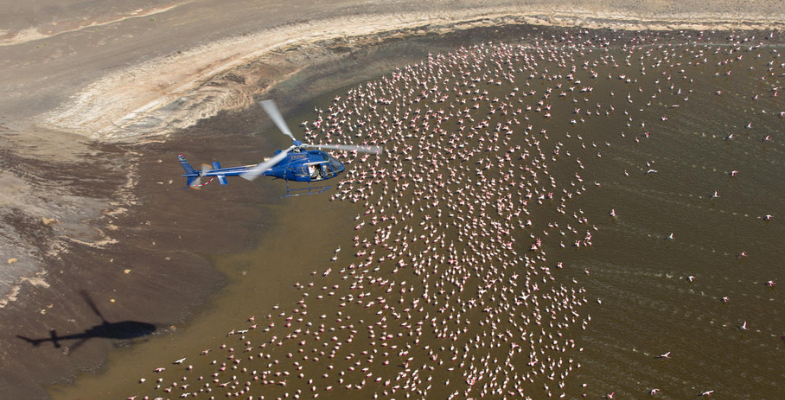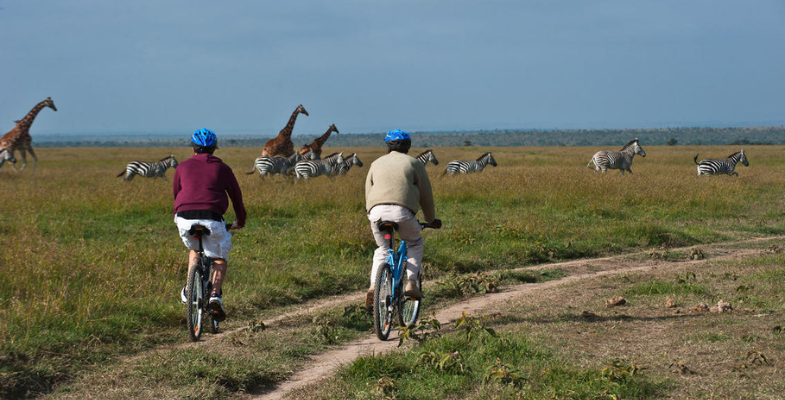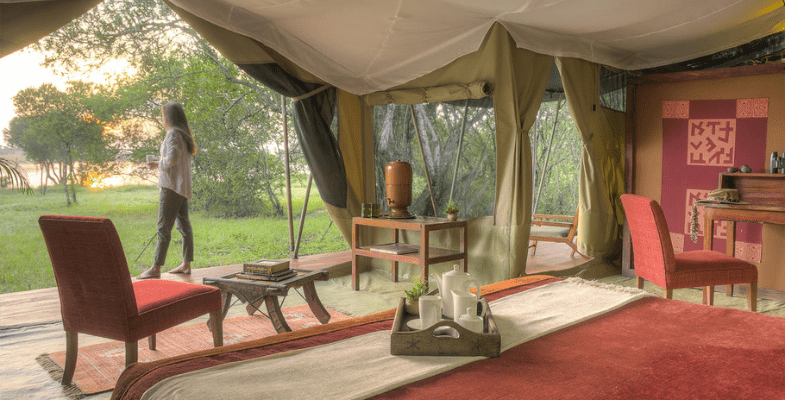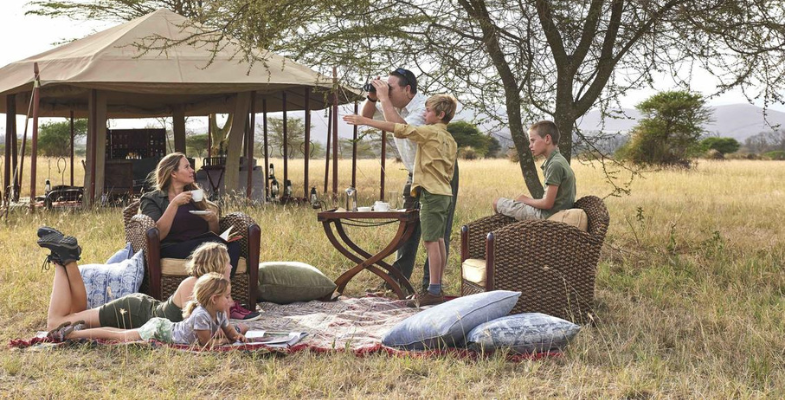An African safari is a once-in-a-lifetime experience, especially if you plan to visit Kenya or Tanzania. There are so many ways to experience these neighbours’ wildlife and untouched bush – with something to suit every kind of adventurer. Did you know you can go hot air ballooning in Kenya and chimpanzee trekking in Tanzania, for example?
Whether you’re an African wilderness first-timer or have already witnessed the life-changing Great Migration in the Serengeti, the amazing East African countries have hidden gems and unique safaris waiting to be discovered. Our travel experts are here to provide you with their top tips and everything you need to know so you can plan the perfect trip to Kenya and Tanzania.
Why Kenya and Tanzania are the wildest duos in East Africa

In the early 1900s, Kenya and Tanzania took the lead in nature conservation and safari tourism. They established national parks and reserves to protect their wildlife and unique ecosystems, creating a haven for adventurous souls. Tanzania, in particular, has protected an impressive 28% of its land area for this purpose!
The Masai Mara Game Reserve and Serengeti National Park, which stretch across the border of Kenya and Tanzania, are some of the most renowned protected areas worldwide. Masai Mara is home to vast lion prides and is considered one of the best places to see cheetahs in the wild. The Serengeti National Park is a UNESCO World Heritage site and is the only place in Africa where expansive land-animal migrations still occur.
When to plan your safari in Kenya and Tanzania

The Great Migration happens all year round in the Serengeti. The best time to visit depends on the wildlife you want to spot. The rain dictates the seasons and wildlife numbers.
- From July to October, the Migration comes to a dramatic climax as massive herds of wildebeest and zebra cross Kenya’s Mara River – avoiding predators as they make a dash for safety and the lush grazing plains of the Masai Mara Game Reserve.
- The herds move to the southern Serengeti and northern Ngorongoro Conservation Area from November to March. This time of year is ideal for birdwatching as migratory species flock in, and for witnessing thousands of new-born calves in the Great Migration.
- Starting in April, wildebeest herds migrate northward, and by May, they gather in large numbers in the central and western Serengeti. Here, you’ll witness gatherings of zebras, Thomson’s gazelles, and Grant’s gazelles.
- In June, the Migration slows as herds reach the south of the Grumeti River to cross pools and channels.
Tip: Well-located safari camps during the river crossing season are scarce. If you’d like to secure a front-row view of the dramatic crossings, book your safari a year in advance or visit when the herds give birth and graze across the plains, which is equally impressive and less crowded. Consult GILTEDGE’S Kenya and Tanzania experts to plan your trip according to the herds’ movements.
Transportation, visas, vaccinations: Getting there

If you’re planning a trip to Kenya and Tanzania and need a tourist visa (except if you’re from one of the lucky exempt countries), you can easily apply online.
The issuing of e-visas can take two to three weeks in Tanzania, and the process is typically quicker in Kenya. Remember to check out the recommended and required vaccines, including yellow fever (which you may not have heard of). For the best medical advice and anti-malaria treatment, visiting a travel clinic a few weeks before you leave is always a good idea.
Tip: For a satisfying trip to Kenya and/or Tanzania, plan for a minimum of two weeks, and build in sufficient transit time. This should allow you to visit at least three camps in different regions, spending three nights at each camp – ample time to fully immerse yourself in the unique experiences offered.
Kenya and Tanzania’s conservation adventures

Both Kenya and Tanzania have amazing conservation areas, some of which are government-funded and others privately owned. Private wilderness areas make significant contributions and promise unforgettable wildlife encounters.
- The Mara North Conservancy in Kenya is famous for appearing in the BBC’s Big Cat Diaries. It’s next to the Maasai Mara National Reserve and plays a critical role in supporting the Serengeti wildebeest migration and protecting endangered African wild dogs and black rhinos.
- Tanzania’s Mahale Mountain National Park has mountainous terrain where some of Africa’s last remaining wild chimps live. Visitors can trek in search of these charming primates, go on game safaris, and hike up Mount Nkungwe.
Tip: Choose a reputable safari operator, like GILTEDGE, for your safari. Look for ethical credentials, such as employing local staff and guides, supporting communities, and participating in conservation efforts.
The rich cultural tapestry of Kenya and Tanzania

Most visitors want a holistic safari experience. Sure, spotting incredible wildlife and being accompanied by knowledgeable guides are still the main highlights, but travellers also want to immerse themselves in the local culture, and there are plenty of interesting ways to do just that.
- Follow in the footsteps of East Africa’s tribes combining time spent with Maasai people.
- Stay at Campi ya Kanziat Chyulu Hills in southern Kenya on a Maasai-owned wilderness reserve.
- Spend time at Segera Retreat in Kenya for genuine cultural experiences such as visiting a Samburu village, meeting women who manage a beading collective, and spending time in a nearby school.
Choosing your safari: Guide to safari types in Kenya and Tanzania

There are so many options when planning a safari in Kenya and Tanzania. Choose the right kind of safari to ensure you have the best type of ‘wild’ time to suit you and your travel partners.
In style
Going upmarket means luxurious touches, small intimate camps, and game drives where you may not see any other tourists at all.
Tip: Discover the wonders of Kenya on an exciting 9-day safari that offers an abundance of wildlife, stunning scenery, and luxurious tented camps. You’ll have the opportunity to bask in the beauty of Lake Elmenteita’s sapphire-blue waters, explore the vast open savannas of Laikipia to spot rare northern species such as Beisa Oryx, and take exhilarating Big Five game drives on the Masai Mara plains.
Mobile camping
This is the most authentic way to see Africa at close hand without sacrificing too many creature comforts.
Tip: From May to July, you can find the Legendary Serengeti Camp in the western part of Serengeti National Park in Tanzania. It’s set in a beautiful spot in Nyasarori, surrounded by acacia trees and close to the Grumeti River. This is when the wildebeest migration passes through, and the males engage in intense battles for dominance. You’ll witness some thrilling wildlife action!
Walking
Unlike a game drive, a walking safari enables you to fully immerse yourself in the bush’s sights, scents, and hues.
Tip: Start your 10-day Tanzania safari with game drives and walking safaris in the remote south of Tarangire National Park. Move on to a stunning camp in Ngorongoro Crater’s highlands. Finish your adventure in the eastern Serengeti, known for its big cats.
Beach-and-bush safaris
A tempting proposition: first, a trip to the land of the Big Five, then an opportunity to unwind next to the Indian Ocean.
Tip: Experience the ultimate 12-night East Africa and island adventure! Discover Tanzania’s stunning wildlife at the Serengeti and Arusha National Parks during your 6-night stay at Singita Serengeti Grumeti. Take in the breathtaking views of Mount Kilimanjaro and Mount Meru before heading to the Maldives for a relaxing beach getaway.
What you need to know: Prepping for your trip to Kenya and Tanzania

What to pack
Opt for casual attire and skip whites, blacks, and blues (they can attract tsetse flies in certain areas). Long sleeves and pants will help keep mosquitos at bay. Bring a cosy jacket to keep you warm during evening game drives. It’s winter in the southern hemisphere during the middle months of the year, and mornings and nights can be chilly.
Bring a camera and binoculars
With improved smartphone cameras, some travellers skip actual cameras, but charging can be an issue on safari. Bring a camera and rent/buy a telephoto lens. If you don’t have one, get one. The photos will be unforgettable.
What to expect on game drives
Road transfers and game drives are conducted in enclosed 4x4s with large windows and pop-up roofs. Game drives occur early morning and late afternoon when wildlife is most active, so be ready for early starts. Remember, this is not a zoo, and animals are not always present. You may only spot them about a third of the time, but the rest of the time, you can enjoy scenic views and learn about wildlife from your guide.
Note local etiquette
Good manners go a long way in Kenya and Tanzania, so be polite when taking photos of the locals. Just ask for permission and be ready for a possible request for a small reward, especially in busy tourist spots.
Don’t expect the comforts of home
Safari lodges offer luxury amidst stunning design but expect some challenges due to their remote locations and limited infrastructure. Be prepared to wait for solar-heated water, for example. Lodges rely on solar power and may have limited Wi-Fi, so embrace this chance to disconnect.
Ready to plan your safari to Kenya or Tanzania?

Don’t make the mistake of cramming too much into a Kenyan and Tanzanian safari. Rushing to see everything in a week will leave you exhausted instead of relaxed. It’s impossible to see all of Africa, or even one country, in one trip. Contact GILTEDGE for expert advice on your next adventure.
